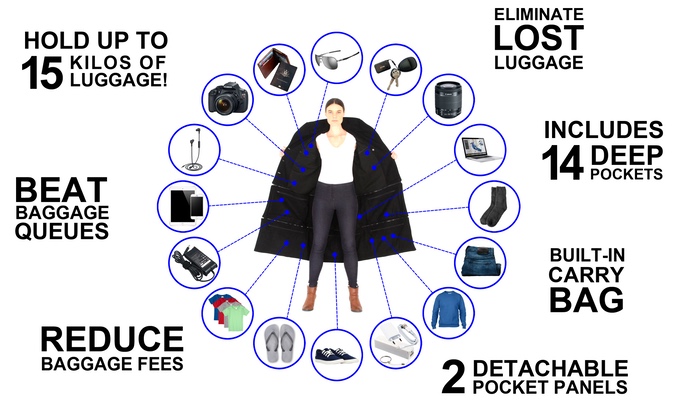The “Airport Jacket” is, for all intents and purposes, a wearable suitcase. With a whopping 14 pockets and two detachable pocket panels capable of taking up to 15 kg of stuff, your only concern will be ensuring your legs don’t give way as you stagger toward the check-in desk.
Crucially, the jacket – with all the stuff inside – can be quickly transformed into a small bag (with handles) so you only need to put it on when you arrive at the airport. Once you’re through check-in and on the plane, you can fold it back up again before throwing it into one of the overhead bins.
Drawbacks? Don’t be surprised if security takes an interest if you’re looking particularly bulky, and you’d better hope airlines don’t cotton on to the ruse or you’ll find yourself reaching for your wallet after all. If you can remember which pocket you put it in.
According to its designer, “the Airport Jacket is capable of carrying a laptop, an iPad, two pairs of shoes, a pair of jeans, three T-shirts, two pairs of shorts, underwear for three to four days, a light jumper, a dress, a liquids bag, wallet, phone, and passport — with room to spare.” Did you get that? With room to spare.

Besides beating excess baggage fees, its creator suggests the Airport Jacket will also help you to skip baggage lines because there will be no need to check-in any luggage.
To take care of all climates — important for true globetrotters — the multigarment collection includes two spring/summer styles and two winter styles for both men and women. The spring/summer design comprises a lightweight water-resistant polyester, while the winter one is 100 percent wool. So, yes, if you travel a lot you might need two of these massive jackets.
The jacket is a Kickstarter project and has till the end of March to raise 100,000 Australian dollars (about $77,000). At the time of writing, interested travelers have pledged 16,000 Australian dollars (about $12,300), but there’s still plenty of time for it to reach its target.
The Airport Jacket comes in various sizes and costs from 239 Australian dollars (about $185) depending on the design , though early bird deals are still available.


